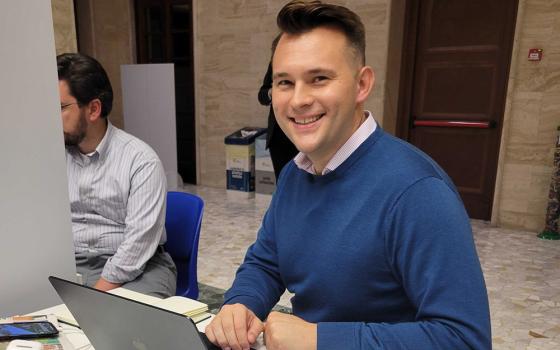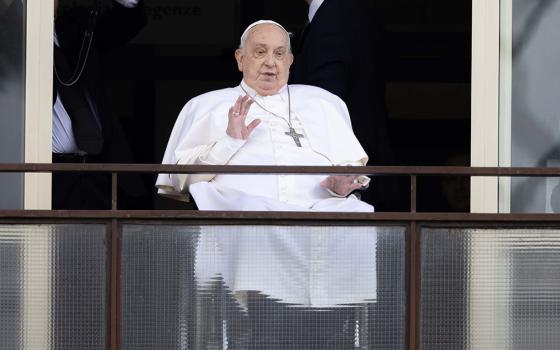
DALLAS -- U.S. women religious leaders say they are today more spiritually rounded and more committed to their Vatican II vision of church than in any time in recent memory. They also say they have strengthened bonds across congregational lines and with women religious overseas.
They trace these welcomed fresh energies to responses they have been forced to hone out as part of two Vatican investigations into their lifestyles and leadership, responses that have involved many hours of self-discernment and strategic planning.
These findings are based on more than two dozen interviews with U.S. women religious leaders during and after the Aug. 10-13 gathering of the Leadership Conference of Women Religious, the networking group that represents 95 percent of the nation’s women religious. Some 750 women leaders gathered in Dallas, and throughout the meetings they were focused on the Vatican probes.
Franciscan Sister of Perpetual Adoration Marlene Weisenbeck, who stepped down as Leadership Conference president at the end of the meeting, told NCR: “We have been moving for over 50 years through massive renewal and reimagining of religious life. Some call it deconstruction. Now we are in the time of the resurrection waltz of reintegration.”
NCR asked Weisenbeck if, given the energy the Vatican investigations have sparked in women religious communities, she would one day come to see them in a positive light. She responded: “You know, I think we’re quite a ways along the road to that being true already. There was anger at first, but as people are having better experiences with the visits, the mood has been changing.”
Rome sent shock waves through U.S. women’s communities and beyond in January 2009 when it announced it was beginning a three-year apostolic visitation, the highest form of church inquiry, to examine their quality of life. Two months later, the women were hit again as the Leadership Conference learned it was the object of a Vatican doctrinal inquiry.
The moves initially brought anger and heartache to the vast majority of U.S. women religious. Some in the church, however, welcomed the initiatives as efforts to rein in women religious who in the decades following the Second Vatican Council (1962-65) had lost their orthodox core.
Meanwhile, the investigations have been viewed as a public slap at the women and another Vatican move to diminish Vatican II influence. As much as any other group in the church, women religious have been seen as an embodiment of council reforms.
A subtext within the unfolding authority story has been the gender story. The probes were called for, are run by, and will be judged by men; each involves the ways women live out their faith.
The apostolic visitation is in its second year. It is being run by the Vatican Congregation for Institutes of Consecrated Life and Societies of Apostolic Life and carried out through an office run by an apostolic visitator, Mother Mary Clare Millea, superior general of the Apostles of the Sacred Heart of Jesus. The investigation has four phases and it is aimed at nearly 400 “institutes,” or communities.
The first phase involved interviews with congregation religious heads; the second required each community to fill out detailed questionnaires about life in the communities; currently the visitation, in its third phase, involves team visits to roughly a third of the communities; the final phase involves the writing of the report to be sent to Rome.
The Vatican has estimated the three-year study will cost more than $1 million.
The Vatican has told the women they will not be allowed to see or to respond to the findings, a part of the process the women find particularly offensive.
Meanwhile, the visitation has come under fire from laity and religious, who have written letters of support to the women’s communities. Cries for solidarity with the women have also come from women religious overseas. Catholics who do not ordinarily get into church disputes have spoken out against the investigation. The most common question these Catholics ask, sometimes in opinion essays or letters to the editor, is: “Why is the Vatican investigating the women religious and not priests and bishops who have been involved in sex abuse and its cover-up?”
The apostolic visitation has been a major focus -- many say “distraction” -- as each community for the past year and a half has had to ponder its responses. It’s been a lengthy process of discernment. Many communities have met with canon lawyers to assess their legal rights. Some, viewing the questionnaire as too intrusive, chose to ignore it; others turned in partial answers; still others returned copies of their congregation’s constitutions, as if to say answers to the Vatican’s questions are contained in the vows they have made.
 Several dozen women’s communities have already been visited, with some 80 more slated for visitations in the next few months, as part of phase three. Visits have been largely formal with mixed degrees of cordiality, the women report. Fearful of being seen somehow as self-promotional, the LCWR leadership has told congregation heads not to comment to the media about the visits.
Several dozen women’s communities have already been visited, with some 80 more slated for visitations in the next few months, as part of phase three. Visits have been largely formal with mixed degrees of cordiality, the women report. Fearful of being seen somehow as self-promotional, the LCWR leadership has told congregation heads not to comment to the media about the visits.
From the investigation’s early days to the Leadership Conference gathering last month, there has been a remarkable shift in the mood among the women religious, many report. Angered at first, they say the investigation has drawn them together, triggered self-reflection, and has led to reaffirmations of religious identity and mission.
One of the most common words used by the women when they refer to the transformation in their communities has been “solidarity.” In Dallas, the women passed only one resolution, calling upon U.S. women religious to work more closely with women religious overseas.
Meanwhile, most say they want to avoid any confrontation with Rome, even as they admit they do not know where their journey is taking them.
During three days of discussions in Dallas, the women repeatedly affirmed their commitments to an earthy, sometimes messy, Gospel-spawned, Vatican II, pastoral vision of church. It is one they say they have tried to uphold for decades.
Blessed Virgin Mary Sr. Many Ann Zollmann of Dubuque, Iowa, the head of her congregation and a past Leadership Conference president, echoed the sentiments of other women in Dallas, saying the gathering was an energizing experience that had brought her much hope. The theme of the gathering seemed appropriate to the women: “Hope in the midst of darkness.”
“More of us see an energy now because we realize this is not just about us, as women religious,” Zollmann said. “We are using this energy and solidarity to step back to say, ‘What are we learning about who we are and how we want to be as we move forward as women in our church?’
“We are no longer waiting to see what Rome is going to do. We are using this energy, the spirit and the solidarity as we move ahead. There is hopefulness. It happens we are in a visible place.”
Referring to the Vatican doctrinal inquiry, Zollmann, in the 10th year of leadership in her community, said that the Leadership Conference of Women Religious is waiting now for a Vatican response to LCWR’s responses. She called it not just a waiting period, but a “fruitful waiting” time, adding, “We are actively creating something together. We want to seize this moment. It is a good moment.”
Zollmann said the spirit she found at the gathering was not that of a beleaguered organization. The contrary was true. She said the gathering was electric, with women affirming commitments and sharing moving liturgies.
She said she returned to her community so excited she was at a loss to find the proper words to describe the events. “Eventually I said, ‘You simply had to be there.’ ”
Franciscan Sr. Pat Farrell, also from Dubuque and the newly elected vice president of the Leadership Conference, said of the Dallas gathering: “There was great energy at the conference and deep connectedness among us. I sensed a galvanized solidarity, ready to extend in more global outreach to women religious around the world.”
Mercy Sr. Camille D’Arienzo, another LCWR past president, said of the meeting: “While we engaged in prayers that upheld the value of hope in the midst of darkness, our liturgies and conversations enveloped us with the bright light of faith.”
 Jane Blabolil, head of the Sisters of St. Joseph of the Third Order of St. Francis, said it “allowed us to see that something new was happening in our communities. As a result [of the sharing], confidence grew among us,” she said.
Jane Blabolil, head of the Sisters of St. Joseph of the Third Order of St. Francis, said it “allowed us to see that something new was happening in our communities. As a result [of the sharing], confidence grew among us,” she said.
Zollmann, asked by NCR if she was ready to see the apostolic visitation in a positive light, responded: “The investigation is not justified, but what is happening is a wonderful unintended consequence.”
Blabolil, referring to the apostolic visitation, said it shows anything can be a blessing. A number of women echoed her, saying God works in unpredictable ways.
Dallas Bishop Kevin Farrell, on the opening evening of the assembly, spoke glowingly about the work of women religious. He noted it was women religious who first evangelized the state of Texas, establishing institutions that responded to people’s spiritual and physical needs. He told them the contributions they have made left him feeling honored to welcome them into his diocese. Farrell’s talk reminded the gathered women they have good friends among the bishops.
Another comforting realization for the women was that the pressures they face mirror those faced by others in the church. While this provides solace, it also puts the women in the spotlight. In both private meetings and public presentations in Dallas, women noted that how they respond to the Vatican in the months ahead will help define them and offer a model to the wider church.
Richard Gaillardetz, professor of Catholic studies at the University of Toledo, Ohio, in a keynote address, made these points in his talk.
“The people of God are watching you, looking for a way forward in their own ecclesial difficulties,” he said. “As I am sure you know, you are not the only ones experiencing the pain of ecclesial tensions. There are other faithful Catholics who struggle with abuses in ecclesiastical authority on many fronts.”
He told the women they are on an ecclesial tightrope: “Veer too far toward the assertion of your proper autonomy and you fall into the abyss of sectarian self-righteousness. Veer too far in the direction of a pseudo docility and unthinking obedience, and you fall yet again, this time into the abyss of ecclesial impotence and irrelevance.”
One week before the women met in Dallas the Vatican announced the appointment of a U.S. Redemptorist priest, Fr. Joseph Tobin, as the new secretary for the Congregation for Institutes of Consecrated Life and Societies of Apostolic Life. Tobin is widely viewed as sympathetic to the women. Weisenbeck referred to him as “family.”
In an interview with NCR, several days before the LCWR gathering, Tobin said he wants to make something positive come out of apostolic visitation. It was not immediately clear if the appointment was an attempt by Rome to send a positive signal to the women at the outset of their meeting. The women appeared to hope this is the case.
Officially, according to a statement made by Cardinal Franc Rodé, head of the Congregation for Institutes of Consecrated Life and Societies of Apostolic Life, the apostolic visitation is a response to “concerns expressed by American Catholics -- religious, laity, clergy and hierarchy -- about the welfare of religious women.” He has also said it is a response to “irregularities or omissions” in their communities. “Most of all, you could say it involves a certain secular mentality that has spread in these religious families and, perhaps, also a certain ‘feminist’ spirit,” he said in one interview.
Rodé, at 75, is soon expected to step down as prefect of the religious congregation. His successor will almost certainly have to determine what to do with the eventual findings.
The Leadership Conference of Women Religious continues to face its own investigation. A March 2009 letter to the conference outlined Rome’s concerns, which include issues of homosexuality, women’s ordination, and the primacy of the Catholic church. Last April when LCWR leaders met with Vatican officials in Rome, the Vatican added to its concerns the fact that Leadership Conference of Women Religious had split with the U.S. bishops over health care legislation last spring.
The bishops at the time said a Democratic Party-sponsored bill allowed funding for abortions; the Leadership Conference of Women Religious and the Catholic Health Association were among Catholic groups who disagreed with that interpretation.
Gaillardetz, in his talk at the Dallas gathering, said the unheralded story of the health care debate was that the U.S. bishops and the women religious agreed on all the moral principles involved.
“What is remarkable to me,” he said, “is that so little has been made of the overwhelming agreement between the Catholic supporters of the legislation and the position of the bishops on every significant moral issue.” The disagreement, he noted, was limited to different interpretations of “exceedingly technical policy jargon.”
At the end of the gathering, Immaculate Heart of Mary Sr. Margaret Brennan was awarded LCWR’s “Outstanding Leadership Award.” Accepting it, the 86-year-old Brennan reminded the women that tensions between the church’s bishops and the women religious go back to the Leadership Conference’s founding. She said these tensions arise out of different roles each has in the church.
“I do believe that the LCWR is gift,” Brennan said, “a gift not of our own making ... but given to us ... and entrusted to us. And I do believe, as well, that this time of apostolic visitation may be one of its finest hours.”
[Thomas C. Fox is NCR editor and can be reached at tfox@ncronline.org.]
Stories in this series
|



